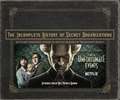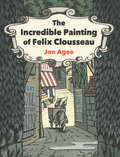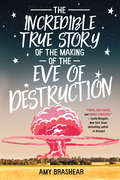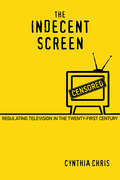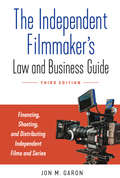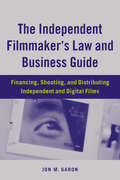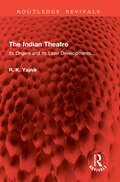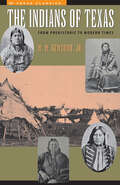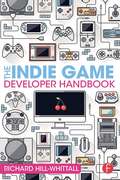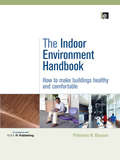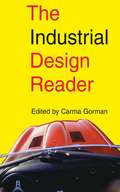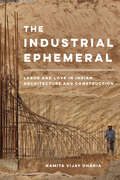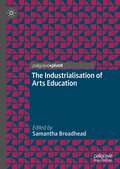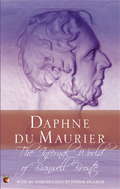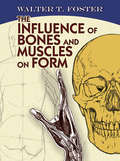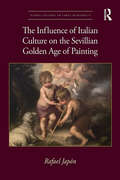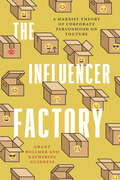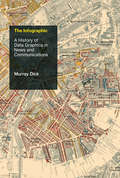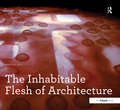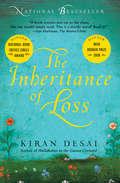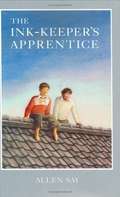- Table View
- List View
The Incomplete History of Secret Organizations: An Utterly Unreliable Account of Netflix's A Series of Unfortunate Events
by Neil Patrick Harris Joe Tracz<P><P><i>Advisory: Bookshare has learned that this book offers only partial accessibility. We have kept it in the collection because it is useful for some of our members. To explore further access options with us, please contact us through the Book Quality link. Benetech is actively working on projects to improve accessibility issues such as these.</i> <P><P>This mysterious illustrated tie-in to Netflix's award-winning A Series of Unfortunate Events--featuring an introduction by Count Olaf's legal representative, Neil Patrick Harris--shares insider secrets about the Baudelaire family and the making of the show. In every library there is a single book that can answer the question that burns like a fire in the mind...In this collector's companion you will discover never-before-seen photographs, never-before-told stories, and never-before, revealed secrets spanning all three seasons of the hilariously twisted, critically acclaimed hit series. You will encounter original concept art, annotated script excerpts, and interviews with the creative team and all-star cast, as well as glossaries, recipes, lyric sheets, hidden Easter eggs, shocking backstories, and suspicious pages from the titular tome, unredacted, and revealed here for the first time.Featuring interviews with: Tony HaleDaniel HandlerAasif MandviSara RueBarry SonnenfeldPatrick WarburtonBo WelchAlfre Woodardand more...Perhaps you are wondering how a noble person such as yourself might become a member of a secret organization. Like so many things in life, it starts by picking up the right book. So go ahead, read at your own risk.
The Incredible Painting of Felix Clousseau
by Jon AgeeArt imitates life in this hilarious, absurdist picture book--one of Jon Agee's most beloved titles, now back in print."Outrageous!" the judges cried. "Ridiculous!" Who would dare enter a portrait of a duck in the Grand Contest of Art? But when Felix Clouseau's painting quacks, he is hailed as a genius. Suddenly everyone wants a Clousseau masterpiece, and the unknown painter becomes an overnight sensation. That's when the trouble begins.
The Incredible True Story of the Making of the Eve of Destruction
by Amy BrashearArkansas, 1984: The town of Griffin Flat is known for almost nothing other than its nuclear missile silos. MAD—Mutually Assured Destruction—is a fear every local lives with and tries to ignore. Unfortunately that’s impossible now that film moguls have picked Griffin Flat as the location for a new nuclear holocaust movie, aptly titled The Eve of Destruction. When sixteen-year-old Laura Ratliff wins a walk-on role (with a plus-one!) thanks to a radio call-in contest, she is more relieved than excited. Mingling with Hollywood stars on the set of a phony nuclear war is a perfect distraction from being the only child in her real nuclear family—which has also been annihilated. Her parents are divorced, and her mother has recently remarried. Her father, an officer in the Strategic Air Command, is absent . . . except when he phones at odd hours to hint at an impending catastrophe. But isn’t that his job? Laura’s only real friend is her new stepbrother, Terrence. She picks him as her plus-one for the film shoot, enraging her fair-weather friends. But their anger is nothing compared to what happens on set after the scripted nuclear explosion. Because nobody seems to know if a real nuclear bomb has detonated or not.
The Indecent Screen: Regulating Television in the Twenty-First Century
by Cynthia ChrisThe Indecent Screen explores clashes over indecency in broadcast television among U.S.-based media advocates, television professionals, the Federal Communications Commission, and TV audiences. Cynthia Chris focuses on the decency debates during an approximately twenty-year period since the Telecommunications Act of 1996, which in many ways restructured the media environment. Simultaneously, ever increasing channel capacity, new forms of distribution, and time-shifting (in the form of streaming and on-demand viewing options) radically changed how, when, and what we watch. But instead of these innovations quelling concerns that TV networks were too often transmitting indecent material that was accessible to children, complaints about indecency skyrocketed soon after the turn of the century. Chris demonstrates that these clashes are significant battles over the role of family, the role of government, and the value of free speech in our lives, arguing that an uncensored media is so imperative to the public good that we can, and must, endure the occasional indecent screen.
The Independent Filmmaker's Law and Business Guide: Financing, Shooting, and Distributing Independent Films and Series
by Jon M GaronToday's independent and digital filmmaking demands a clear guide to the business and legal aspects of the art. What fundraising options are available to a filmmaker? When should a filmmaker establish a corporation or limited liability company? How do screenwriters protect their work? What are a director's legal obligations to the producer, cast, and crew--and what are their obligations in return? This indispensable resource addresses the legal, financial, and organizational questions that an independent or guerrilla filmmaker must face, and the problems that will doom a project if left unanswered. It demystifies issues such as founding a film company, obtaining financing, preparing a budget, securing locations, shooting, granting screen credits, and distributing, exhibiting, and marketing a film. Newly updated and expanded, this third edition explores concepts such as integrating social media; crowd funding and nonprofit status funding; diversity, inclusion, and compensation equity; and distribution via streaming services. Six appendixes provide sample contracts, copyright circulars, Documentary Filmmakers' Statement of Best Practices in Fair Use, and more.
The Independent Filmmaker's Law and Business Guide: Financing, Shooting, and Distributing Independent and Digital Films
by Jon M. GaronPreparing independent or guerrilla filmmakers for the legal, financial, and organizational questions that can doom a project if unanswered, this guide demystifies issues such as developing a concept, founding a film company, obtaining financing, securing locations, casting, shooting, granting screen credits, distributing, exhibiting, and marketing a film. Updated to include digital marketing and distribution strategies through YouTube or webisodes, it also anticipates the "problems" generated by a blockbuster hit: sound tracks, merchandizing, and licensing. Six appendices provide sample contracts, copyright forms and circulars, Writer's Guild of America definitions for writing credits, and studio contact information.
The Indian Theatre: Its Origins and Its Later Developments... (Routledge Revivals)
by R. K. YajnikFirst published in 1933, The Indian Theatre provides a comprehensive overview of the origin and the later developments of theatre in India under European influence with special reference to Western India. It discusses important themes such as the early Indian stage; the ancient Hindu stage; the rise of modern theatres; stage-versions of Shakespearean comedies; stage-versions of Shakespearean tragedies; influence of non-Shakespearean plays and the general influence of British drama.The first four chapters provides the religious basis of the Sanskrit drama, it's essentially idealistic, poetic and romantic atmosphere along with its characteristic contribution of the rasa theory. The second part of the book discusses the rise of the European theatres, mostly amateur in character, in the three great cities of India- Calcutta, Bombay and Madras. This is an important historical reference work for students and scholars of Indian theatre, theatre history, and theatre and performance studies.
The Indians of Texas: From Prehistoric to Modern Times (Texas History Paperbacks)
by W. W. Newcomb Jr.After viewing Indian rock paintings on a bluff above the Concho River near Paint Rock, Texas, in 1934, the late Dallas artist Forrest Kirkland was seized with an idea. He wrote later, "Here was a veritable gallery of primitive art at the mercy of the elements and the hands of a destructive people. In a few more years only the hundreds of deeply carved names and smears of modern paint would remain to mark the site of the paintings left by the Indians. . . . What was at first merely a suggestion in my mind soon became a solemn command. I was a trained artist able to make accurate copies of these Indian paintings. I should save them from total ruin. "Kirkland devoted a good part of the rest of his life to copying pictographs and petroglyphs at some eighty far-flung sites in Texas. In The Rock Art of Texas Indians, his meticulous watercolor copies of this rich and diversified art are reproduced, 32 in full color, the rest in black and white. The informative and engaging text is contributed by W. W. Newcomb, Jr. , former director of the Texas Memorial Museum and author of The Indians of Texas. The petroglyphs and pictographs reproduced here, states Professor Newcomb, "are relatively rare and absolutely irreplaceable human documents. They can often reveal much about the ways of ancient men, including aspects of life which otherwise would forever go unrecorded, for they may illustrate how a vanished, nameless people perceived themselves and their world, their relation to God and to each other, and their fantasies and fears. They are, then, a treasure to be valued and a heritage to be preserved. "
The Indie Game Developer Handbook
by Richard Hill-WhittallThe indie game developer’s complete guide to running a studio. <P><P>The climate for the games industry has never been hotter, and this is only set to continue as the marketplace for tablets, consoles and phones grow. Seemingly every day there is a story of how a successful app or game has earned thousands of downloads and revenue. As the market size increases, so does the number of people developing and looking to develop their own app or game to publish. The Indie Game Developer Handbook covers every aspect of running a game development studio—from the initial creation of the game through to completion, release and beyond. <P><P> Accessible and complete guide to many aspects of running a game development studio from funding and development through QA, publishing, marketing, and more. <P><P> Provides a useful knowledge base and help to support the learning process of running an indie development studio in an honest, approachable and easy to understand way. <P><P> Case studies, interviews from other studies and industry professionals grant an first-hand look into the world of indie game development
The Indoor Environment Handbook: How to Make Buildings Healthy and Comfortable
by Philomena BluyssenWinner of the Choice Outstanding Academic Titles of 2010 award. Ensuring that buildings are healthy and comfortable for their occupants is a primary concern of all architects and building engineers. This highly practical handbook will help make that process more efficient and effective. It begins with a guide to how the human body and senses react to different indoor environmental conditions, together with basic information on the parameters of the indoor environment and problems that can occur. It then moves on to give a background to the development of the study and control of the indoor environment, examining the main considerations (including thermal, lighting, indoor air and sound-related aspects) for a healthy and comfortable indoor environment and discussing the drivers for change in the field. The final section presents a new approach towards health and comfort in the indoor environment, where meeting the wishes and demands of the occupants with a holistic strategy becomes the over-riding priority. The book is filled with useful facts, figures and analysis, and practical methods that designers who are keen to assess and improve the user experience of their buildings will find invaluable.
The Industrial Design Reader
by Carma GormanWith input from a diverse range of industry experts/designers, theorists, critics, historians, and curators, this anthology is the first to focus exclusively on the history of industrial design. This pioneering guide traces the entire history of industrial design, industrialization, and mass production from 1850 until today. Sixty comprehensive essays written by designers, theorists, advertisers, historians, and curators detail the most crucial movements, issues, and accomplishments of industrial design. They combine news reports on the very first design workshops, aesthetic manifestos, lectures, and more from the biggest names in the field: William Morris, Henry Dreyfuss, and Victor Papanek, to name only a few. The Industrial Design Reader is an excellent resource for educators, students, and practicing designers.
The Industrial Ephemeral: Labor and Love in Indian Architecture and Construction (Atelier: Ethnographic Inquiry in the Twenty-First Century #7)
by Namita Vijay DhariaWhat transformative effects does a multimillion-dollar industry have on those who work within it? The Industrial Ephemeral presents the untold stories of the people, politics, and production chains behind architecture, real estate, and construction in areas surrounding New Delhi, India. The personal histories of those in India's large laboring classes are brought to life as Namita Vijay Dharia discusses the aggressive environmental and ecological metamorphosis of the region in the twenty-first century. Urban planning and architecture are messy processes that intertwine migratory pathways, corruption politics, labor struggle, ecological transformations, and technological development. Rampant construction activity produces an atmosphere of ephemerality in urban regions, creating an aesthetic condition that supports industrial political economy. Dharia's brilliant analysis of the sensibilities and experiences of work lends visibility to the struggle of workers in an era of growing urban inequality.
The Industrialisation of Arts Education
by Samantha BroadheadThis book comprises the responses of a group of multi-disciplinary writers/ researchers/practitioners to the proposition that arts education in the twentyfirst century has become industrialised. Historical and contemporary examples of how arts education prepares students for working in industry are discussed to show how the expectations of educators, students and industry representatives do not always concur. The extent to which arts pedagogies have been informed by the agendas of the cultural industries as well as wider neoliberal ideologies are also considered. This leads to questions about the function and value of arts education. The debates expose tensions of producing students who are ‘industryready’ in an educational context that must, at the same time, consider other issues such as sustainability and widening participation. Writers, educators and researchers in vocational education, creative writing, jewellery design, animation, fashion branding and popular music investigate the complexities relating to this topic from their own diverse points of view.
The Infernal World Of Branwell Bronte (Virago Modern Classics #126)
by Daphne Du MaurierFROM THE BESTSELLING AUTHOR OF REBECCAAs a bold and gifted child, Branwell Bronte's promise seemed boundless to the three adoring sisters over whom his rule was complete. But as an adult, the precocious flame of genius distorted and burned low.With neither the strength nor the resources to counter rejection, unable to sell his paintings or publish his books, Branwell became a spectre in the Bronte story, in pathetic contrast with the astonishing achievements of his sisters.Daphne du Maurier concentrates all her biographer's skill on the shadowy figure of Branwell Bronte, and no reader could fail to be intensely moved by Branwell's final retreat into laudanum, alcohol - and death
The Infernal World Of Branwell Bronte (Vmc Ser. #664)
by Daphne Du MaurierFROM THE BESTSELLING AUTHOR OF REBECCAAs a bold and gifted child, Branwell Bronte's promise seemed boundless to the three adoring sisters over whom his rule was complete. But as an adult, the precocious flame of genius distorted and burned low.With neither the strength nor the resources to counter rejection, unable to sell his paintings or publish his books, Branwell became a spectre in the Bronte story, in pathetic contrast with the astonishing achievements of his sisters.Daphne du Maurier concentrates all her biographer's skill on the shadowy figure of Branwell Bronte, and no reader could fail to be intensely moved by Branwell's final retreat into laudanum, alcohol - and death
The Inferno: (The Definitive Illustrated Edition) (Penguin Twentieth-Century Classics)
by Dante Alighieri Henry Wadsworth Longfellow Gustave DoréIn 1867, when Henry Wadsworth Longfellow published the first American edition of The Inferno, Dante was almost unknown in this country. The New England poet and educator, who taught Italian literature at Harvard, introduced Dante's literary genius to the New World with this vibrant blank verse translation of the first and most popular book of the three-part Divine Comedy. Expressed in haunting poetry of great emotional power, The Inferno chronicles Dante's passage through nine circles of the underworld and his encounters with tormented sinners. Combining Aristotelian philosophy, mythology, Roman Catholicism, and thirteenth-century Italian politics, this landmark of world literature forms a unique synthesis of the Christian, classical, and secular worlds.Dante's depictions of hell and its grotesque punishments found their ideal match in the hands of the eminent nineteenth-century illustrator Gustave Doré. Unable to find a sponsor, the artist published his stunning engravings for The Inferno at his own expense. An instant and enduring success, Doré's images made a lasting impression on the public imagination. This volume's enchanting translation and unforgettable illustrations offer readers a perfect blend of literary and artistic skill.
The Influence of Bones and Muscles on Form (Dover Anatomy for Artists)
by Walter T. FosterA thorough acquaintance with human anatomy is a valuable asset for artists wishing to master figure drawing. This single-volume treatment combines separate treatises on drawing muscles and bones. Each page features multiple illustrations, accompanied by extensive descriptions offering lucid explanations of bone and muscle placement, function, and artistic re-creation.
The Influence of Italian Culture on the Sevillian Golden Age of Painting (Visual Culture in Early Modernity)
by Rafael JapónThis book explores the cultural exchange between Italy and Spain in the seventeenth century, examining Spanish collectors’ predilection for Italian painting and its influence on Spanish painters. Focused on collecting and using a novel methodology, this volume studies how the painters of the Sevillian school, including Francisco Pacheco, Diego Velázquez, Alonso Cano and Bartolomé Esteban Murillo, perceived and were influenced by Italian painting. Through many examples, it is shown how the presence in Andalusia of various works and copies of works by artists such as Michelangelo, Caravaggio and Guido Reni inspired famous compositions by these Spanish artists. In addition, the book delves into the historical, political and social context of this period. The book will be of interest to scholars working in art history, Renaissance studies, and Italian and Spanish history.
The Influencer Factory: A Marxist Theory of Corporate Personhood on YouTube
by Grant Bollmer Katherine GuinnessInfluencers are more than social media personalities who attract attention for brands, argue Grant Bollmer and Katherine Guinness. They are figures of a new transformation in capitalism, in which the logic of the self is indistinguishable from the logic of the corporation. Influencers are emblematic of what Bollmer and Guinness call the "Corpocene": a moment in capitalism in which individuals achieve the status of living, breathing, talking corporations. Behind the veneer of leisure and indulgence, most influencers are laboring daily, usually for pittance wages, to manufacture a commodity called "the self"—a raw material for brands to use—with the dream of becoming corporations in human form by owning and investing in the products they sell. Refuting the theory that digital labor and economies are immaterial, Bollmer and Guinness search influencer content for evidence of the material infrastructure of capitalism. Each chapter looks to what literally appears in the backgrounds of videos and images: the houses, cars, warehouses, and spaces of the market that point back to the manufacturing and circulation of consumer goods. Demonstrating the material reality of producing the self as a commodity, The Influencer Factory makes a crucial contribution to our understanding of contemporary economic life.
The Infographic: A History of Data Graphics in News and Communications (History and Foundations of Information Science)
by Murray DickAn exploration of infographics and data visualization as a cultural phenomenon, from eighteenth-century print culture to today's data journalism.Infographics and data visualization are ubiquitous in our everyday media diet, particularly in news—in print newspapers, on television news, and online. It has been argued that infographics are changing what it means to be literate in the twenty-first century—and even that they harmonize uniquely with human cognition. In this first serious exploration of the subject, Murray Dick traces the cultural evolution of the infographic, examining its use in news—and resistance to its use—from eighteenth-century print culture to today's data journalism. He identifies six historical phases of infographics in popular culture: the proto-infographic, the classical, the improving, the commercial, the ideological, and the professional.Dick describes the emergence of infographic forms within a wider history of journalism, culture, and communications, focusing his analysis on the UK. He considers their use in the partisan British journalism of late eighteenth and early nineteenth-century print media; their later deployment as a vehicle for reform and improvement; their mass-market debut in the twentieth century as a means of explanation (and sometimes propaganda); and their use for both ideological and professional purposes in the post–World War II marketized newspaper culture. Finally, he proposes best practices for news infographics and defends infographics and data visualization against a range of criticism. Dick offers not only a history of how the public has experienced and understood the infographic, but also an account of what data visualization can tell us about the past.
The Inhabitable Flesh of Architecture (Design Research in Architecture)
by Marcos CruzToday’s architecture has failed the body with its long heritage of purity of form and aesthetic of cleanliness. A resurgence of interest in flesh, especially in art, has led to a politics of abjection, completely changing traditional aesthetics, and is now giving light to an alternative discussion about the body in architecture. This book is dedicated to a future vision of the body in architecture, questioning the contemporary relationship between our Human Flesh and the changing Architectural Flesh. Through the analysis and design of a variety of buildings and projects, Flesh is proposed as a concept that extends the meaning of skin, one of architecture’s most fundamental metaphors. It seeks to challenge a common misunderstanding of skin as a flat and thin surface. In a time when a pervasive discourse about the impact of digital technologies risks turning the architectural skin ever more disembodied, this book argues for a thick embodied flesh by exploring architectural interfaces that are truly inhabitable. Different concepts of Flesh are investigated, not only concerning the architectural and aesthetic, but also the biological aspects. The latter is materialised in form of Synthetic Neoplasms, which are proposed as new semi-living entities, rather than more commonly derived from scaled-up analogies between biological systems and larger scale architectural constructs. These ’neoplasmatic’ creations are identified as partly designed object and partly living material, in which the line between the natural and the artificial is progressively blurred. Hybrid technologies and interdisciplinary work methodologies are thus required, and lead to a revision of our current architectural practice.
The Inherent Potential in Art Performance: To Critically Challenge Art Traditions in Scenes of Love and Sexual Desire (Routledge Advances in Theatre & Performance Studies)
by Iris JulianThis book spotlights artworks and art performances whose common denominator is the theme of (self-)representation of artists in the 'woman' category in scenes of love and sexuality. Pursuing the research practice of deep drilling, this study presents various methodologies and research directions to create diverse perspectives on the selected artworks. This book combines historical outlines based on art history, visual culture studies, new methodologies in theatre studies and digressions into sociology. Philosophical readings will complement the resulting multiple perspective, in which figures of thought such as transimmanence, the theory of performativity and body-mind dualism are of specific interest. This research brings to the fore networks of sedimented and entangled histories and their role in shaping our ways of seeing. This study will be of great interest to scholars and students in dance, dance performance and art performance.
The Inheritance of Loss (Popular Penguins Series)
by Kiran DesaiIn a crumbling, isolated house at the foot of Mount Kanchenjunga in the Himalayas lives an embittered judge who wants only to retire in peace, when his orphaned granddaughter, Sai, arrives on his doorstep. The judge’s cook watches over her distractedly, for his thoughts are often on his son, Biju, who is hopscotching from one gritty New York restaurant to another. Kiran Desai’s brilliant novel, published to huge acclaim, is a story of joy and despair. Her characters face numerous choices that majestically illuminate the consequences of colonialism as it collides with the modern world.
The Ink-Keeper's Apprentice
by Allen SayA fourteen-year-old boy lives on his own in Tokyo and becomes apprenticed to a famous Japanese cartoonist.
The Inker's Shadow (Scholastic Press Novels)
by Allen SayFor Allen Say, life as teen in Southern California was a cold existence. His father, one of the leading hamburger salesmen in Japan, ran a booming burger business, much like McDonald's
